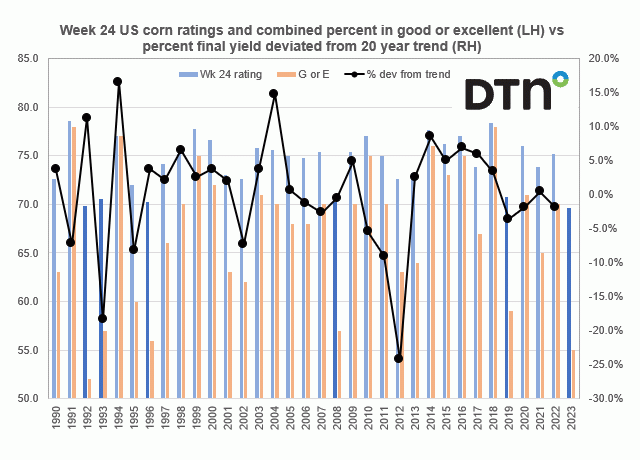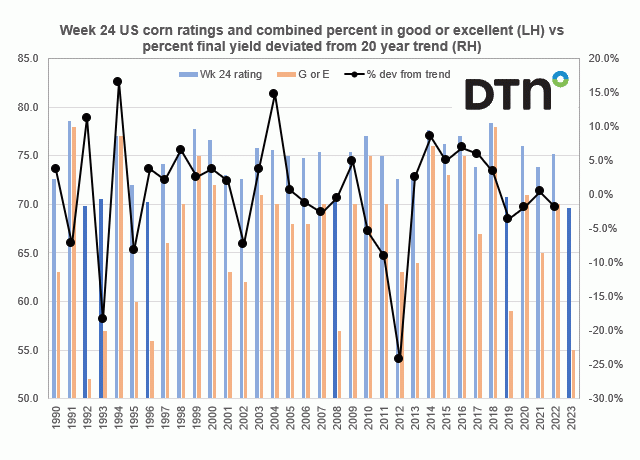Fundamentally Speaking
Possible Corn Futures Prices
As of Tuesday June 16, the Commodity Futures Trading Commission (CFTC) weekly commitment of traders report (COT) showed the managed money or fund short position in corn futures reduced by 24,270 contracts but their short position of 277,603 is historically large.
With 2020 U.S. production pegged at a record 16.0 billion bushels (bb), beginning stocks in excess of 2.0 bb and large questions on 2020/21 demand due to the pandemic, the outlook for corn is decidedly bearish.
Despite this, corn futures have pushed about 25 cents higher since bottoming on April 21.
Many of these recently established fund short positions are now underwater and they may be forced to cover if prices continue to appreciate and push past these two-month highs.
The question is, what catalyst could trigger this fund shortcovering?
P[L1] D[0x0] M[300x250] OOP[F] ADUNIT[] T[]
In our mind, only an abrupt turn toward more adverse growing conditions or if large corn, ethanol and DDG purchases by China were to occur, and for now neither of these appear on the horizon.
Nonetheless, this graphic tries to answer the question of if funds start to cover their large short position in corn futures, how high could that process drive prices?
This chart shows the net managed fund position on contracts on the left hand axis for each Tuesday and the spot corn futures price that day on the right hand axis in $ per bushel.
The period studied is Jan 1, 2015 to this past Tuesday 6/16/20 and we see that the current short of 277,603, which was a net short of 301,873 contracts the week prior is the second largest fund short seen over the past 5 1/2 years other than a fund short as large as -344,185 seen last April 23.
We were interested in corn futures price action when the fund short was at least around 200,000 short and tracked both the net reduction of that short over the period of weeks and also the change in corn prices and these are highlighted in the red boxes.
The first period from 5/16/2015 shows funds short 158,406 contracts and by 7/20/15 had bought 406,197 contracts to be net long 247,791, causing corn prices to rally 40 cents in the process.
The second period from 1/12/2016 shows funds short 195,338 contracts and by 2/2/16 had bought 131,550 contracts to be net short 63,788 contracts causing corn prices to rally 3 cents in that time.
The third period from 3/8/2016 shows funds short 236,201 contracts and by 6/14/16 had bought 504,613 contracts to be net long 268,412 contracts causing corn prices to rally 72 cents in that time.
The fourth period from 9/6/2016 shows funds short 186,127 contracts and by 11/8/16 had bought 172,649 contracts to be net short 13,478 contracts causing corn prices to rally a dime in that time.
There are other periods, but one to note is last year when the fund short maybe was the largest ever at -344,185 and by the time the fund shortcovering and new buying finished, they had shifted to a large long of 178,732 contracts from April 23 to July 16 buying a massive 522,917 contracts over this period rallying corn prices 80 cents per bushel during that time.
Perhaps using net futures as opposed to net futures and options is not as useful, but using these different time periods it appears that when funds are short around 200,000 contracts or more every 100,000 contracts of shortcovering results in a 10-cent advance in corn prices.
This suggests were the funds to go from this net short to even, it could pop corn prices 30 cents though no doubt farmer selling will lean into that.
© (c) Copyright 2020 DTN, LLC. All rights reserved.








Comments
To comment, please Log In or Join our Community .